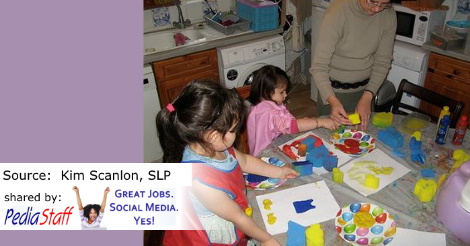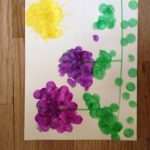SLP Corner: How Arts and Crafts Help Develop Language in Young Children
by Kimberly Scanlon, MA CCC-SLP

I love doing simple arts and crafts projects with my toddler and preschool aged clients. I prefer the ones that:
1. Aren’t too messy
2. Don’t require too many materials
In my experience as a speech language pathologist, the easier and cleaner the activity, I more time I have to focus on language and speech and less on setting up and cleaning up. Also, I have found that when the project is easier or age appropriate, the child can independently perform the steps and thereby further enhance their autonomy and confidence. HOWEVER, I do realize that some professionals believe that messy activities are preferred for engaging the senses and making it a more tactile experience. Of course, this all depends on what you’re trying to achieve. For me, (in most cases) I’m targeting speech and language, which is why I like less messy ones.
I like arts and crafts activities for toddlers and preschoolers for the following reasons:
- Improves attention and concentration. This is because when you’re doing an arts and crafts activity you have to use some hand-eye coordination which requires focus. Also, creating something takes time. It’s not going to just magically appear in seconds (unlike some tablet technology). This helps to teach children to delay immediate gratification. Children learn patience and realize that they need to complete steps to finish a quality project.
- Increases communication. When making something with their hands, children may need to ask for help, may need to request a certain tool or piece of material, or they may simply want to express that they’re having a hard time squeezing the glue out of the bottle. Additionally, because they created something visual and tangible, they can talk about it. When children bring their projects home, this provides the perfect segue to talk about what they made. A word of caution – just try to restrain yourselves from initially asking, “What is it?” Start with a few comments and see if your child will contribute some additional information on his own (e.g. Wow, that’s really nice. I like the colors. I see blue, yellow…etc). Too often adults ask too many questions, which decrease the child’s desire to engage in dialogue or conversation.
- Increases child’s confidence. What child doesn’t like seeing their masterpieces displayed for all to see? It’s super important to display their projects on the fridge, bulletin board, wall, etc and sincerely appreciate their creations.
- Introduces child to language concepts like prepositions, comparatives, opposites and gives opportunities to target following directions. Arts and crafts provide the perfect opportunity to naturally introduce children to prepositions (put some glue on the black line), comparatives (make the circle bigger than the square), opposites (the paper is smooth, but the sandpaper is rough). Children learn more when engaged. Pressuring them to do flashcards, worksheets or memorizing lists isn’t effective for young children. Why? Because flashcards, lists and worksheets are one dimensional. They need to experience something in order to fully understand and encode it.
- Provides ample opportunities for incidental learning. A majority of children learn new words incidentally This means they learn new words when they are engaged in an activity, experiencing something, or learning about something else. The learning happened “randomly” or it was not planned. For instance, a young child incidentally learns the meaning of “spicy” because he wanted to try a new sauce on his taco. If the sauce was really spicy it will probably sear an image in his memory (put in a cute idiom). The beauty about incidental learning is that you, the parent, speech language pathologist or educator can facilitate it by selecting something the child is interested in and indirectly targeting it in activity. Arts and crafts provide the perfect platform for incidental learning.
- Improves Pragmatics and Social Interaction. Making arts and crafts create a natural context in which to take turns , to ask for help, to compliment another’s work, to tell stories, and to share about past or future experiences or events.
For some tips and activities to help develop your child’s language, check out My Toddler Talks: Strategies and Activities to Promote Your Child’s Language Development on Amazon.com.
Here are some great arts and crafts activities to improve your child’s speech and language skills:



Featured Contributor: Kimberly Scanlon, M.A. CCC-SLP,
Kimberly Scanlon, M.A. CCC-SLP, is a speech language pathologist practicing in Bergen County, NJ. She provides home based speech therapy for children and adults through her private practice Scanlon Speech Therapy, LLC. Recently, she published her first book, My Toddler Talks: Strategies and Activities to Promote Your Child’s Language Development. To learn more, please visit www.scanlonspeech.com.
PediaStaff is Hiring!
All JobsPediaStaff hires pediatric and school-based professionals nationwide for contract assignments of 2 to 12 months. We also help clinics, hospitals, schools, and home health agencies to find and hire these professionals directly. We work with Speech-Language Pathologists, Occupational and Physical Therapists, School Psychologists, and others in pediatric therapy and education.
